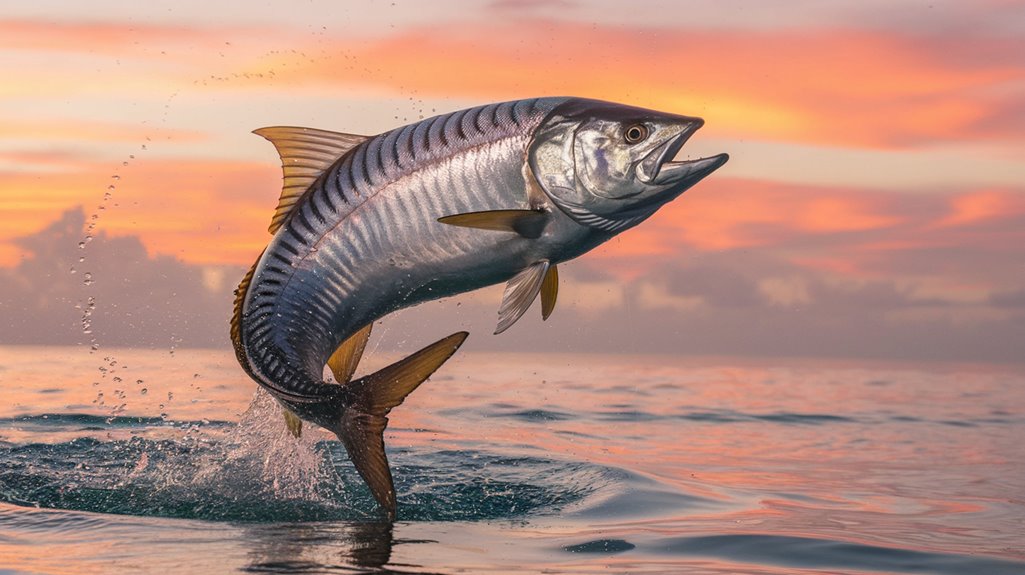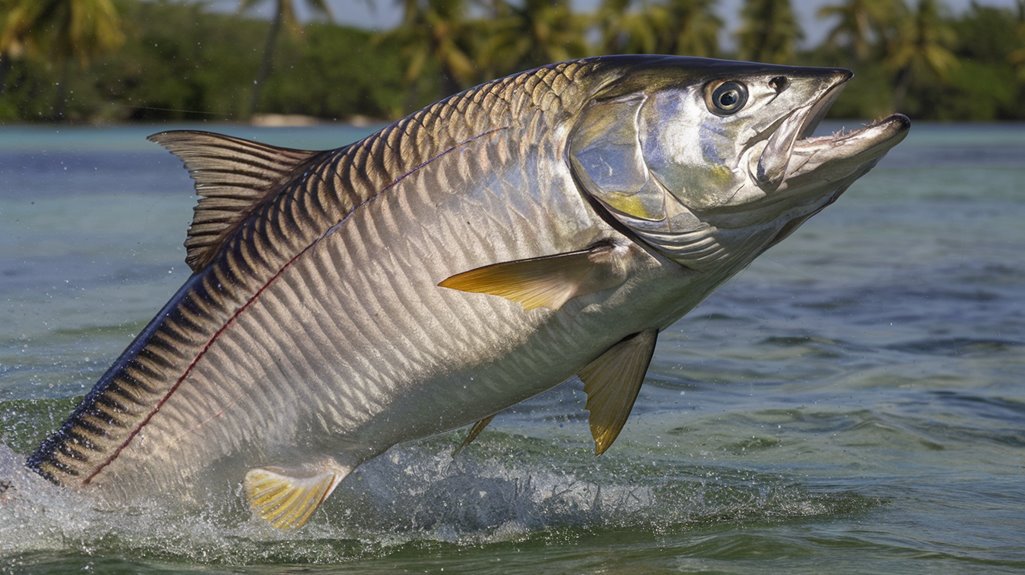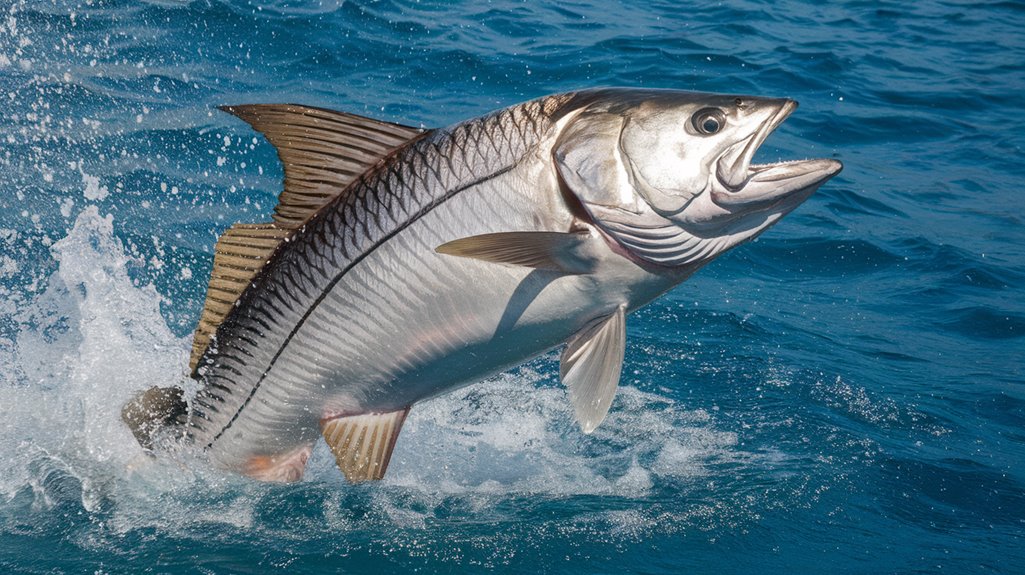You've likely heard the term "Silver King" in fishing circles, but this regal nickname carries more significance than mere angling jargon. The tarpon's distinctive metallic scales create a mesmerizing flash in coastal waters, earning this ancient fish its noble title. Beyond its spectacular appearance, the species boasts remarkable adaptations and behaviors that have shaped coastal cultures for generations, influencing everything from local economies to conservation movements.
Key Takeaways
- Tarpon's metallic scales create a mirror-like reflection in sunlight, earning them the prestigious "Silver King" nickname.
- The title "Silver King" represents their impressive size, reaching up to seven feet and weighing over 200 pounds.
- Tarpon's regal status grew during the early 1900s, significantly influencing coastal tourism and economics in Texas and Florida.
- The nickname symbolizes the ultimate angling challenge due to their powerful jumps and strategic battle tactics.
- Historical events, like FDR's 1937 fishing trip, cemented the Silver King's cultural significance in American sport fishing.
The Legend Behind the Royal Nickname

Anyone who has witnessed a tarpon leaping from coastal waters can understand how this magnificent fish earned its regal moniker. When sunlight strikes the tarpon's large, metallic scales, it creates a dazzling spectacle that transforms the fish into a living mirror, reflecting brilliant flashes across the water's surface. This spectacular display, combined with the fish's imposing size and strength, led to its coronation as the "silver king" among anglers.
You'll find this prestigious title deeply embedded in fishing culture, particularly along the coastlines of South Texas and Florida. The nickname has transcended mere description to become a symbol of the ultimate angling challenge, representing both the physical grandeur of the species and its historical significance in recreational fishing, where it continues to reign as an iconic gamefish.
Physical Traits of a Majestic Fighter
Beyond their shimmering appearance, tarpon possess remarkable physical attributes that make them formidable opponents in the water. You'll find these ancient creatures stretching up to seven feet in length and tipping the scales at over 200 pounds. Their unique swim bladder functions like a pair of lungs, enabling them to thrive in oxygen-depleted waters where other fish can't survive.
| Feature | Function | Advantage |
|---|---|---|
| Large Scales | Light Reflection | Predator Deterrent |
| Swim Bladder | Air Breathing | Survival in Low Oxygen |
| Muscular Body | Power Generation | Enhanced Jumping |
| Juvenile Fangs | Prey Capture | Feeding Efficiency |
| Ribbon Form | Hydrodynamics | Swift Movement |
These physical adaptations culminate in a fish that can launch itself 20 feet into the air, demonstrating both raw power and athletic grace that's unmatched in coastal waters.
Ancient Adaptations and Survival Skills

You'll find the tarpon's most remarkable adaptation in its air-breathing capability, achieved through a specialized swim bladder containing lung-like tissue that evolved over 125 million years. When facing oxygen-depleted waters, you can observe these ancient fish performing their characteristic rolling behavior at the surface to gulp air, supplementing their oxygen intake through both gills and swim bladder. This dual breathing system lets you understand how tarpons have mastered survival in low-oxygen environments, from brackish backwaters to open oceans, making them exceptionally resilient predators.
Air-Breathing Evolution Process
Through millions of years of evolution, the tarpon has developed one of the most remarkable respiratory adaptations in the marine world – a specialized swim bladder that functions similarly to a primitive lung. You'll find this air-breathing evolution process dates back approximately 125 million years, as evidenced by fossil records. The tarpon's swim bladder contains spongy respiratory tissue that's remarkably similar to human lung tissue, allowing these fish to extract oxygen directly from air. They've evolved a unique passageway connecting their swim bladder to their esophagus, enabling them to gulp air at the water's surface. These evolutionary adaptations give tarpon a distinct advantage in low-oxygen environments where other large fish species can't survive, demonstrating nature's ingenious solution to environmental challenges.
Low-Oxygen Water Mastery
While many fish species struggle in oxygen-depleted waters, tarpon have mastered survival in these challenging environments thanks to their sophisticated respiratory system. Their remarkable swim bladder, containing lung-like tissue, enables them to thrive where other fish can't.
You'll find tarpon's mastery of low-oxygen habitats demonstrated through:
- Their ability to extract oxygen directly from air when water conditions become unfavorable
- A specialized passageway connecting their swim bladder to their esophagus, enabling efficient air gulping
- Surface-rolling behavior that serves as both a survival mechanism and a signal to anglers
This adaptation has secured tarpon's position in diverse marine ecosystems, from oxygen-rich coastal areas to more challenging environments. Their success in these varied habitats has made them integral to local fishing culture and ecological diversity.
Historical Impact on Coastal Communities
Since the early twentieth century, the tarpon's majestic presence has profoundly shaped the development of coastal communities along the Gulf of Mexico. You'll find that the "Silver King" transformed coastal economies, as evident in South Texas where tarpon fishing became a bucket list activity for thousands of anglers by the mid-1900s.
| Era | Impact |
|---|---|
| 1900s | Rise of recreational fishing |
| 1930s | FDR's visit boosts popularity |
| 1940s | Peak tourism in Port Aransas |
| Present | Annual tournaments & events |
The town formerly known as Tarpon, Texas, stands as a monument to this fish's cultural significance. The species' popularity peaked during Roosevelt's 1937 visit, cementing South Texas's reputation as a premier fishing destination. Today, you'll witness the tarpon's enduring legacy through vibrant fishing tournaments that continue to drive tourism and strengthen community bonds.
Battle Tactics of the Ocean's Monarch

When you're battling a tarpon, you'll witness their signature aerial acrobatics as they launch up to 20 feet skyward, employing a tactical display that often results in hook release. You'll find these powerful fish using deep water columns to their advantage, combining their air-breathing capability with sudden depth changes to exhaust both angler and equipment. The tarpon's remarkable strength becomes most evident near structures, where they'll test your skills by attempting to wrap your line around pilings, roots, or reefs, requiring precise tension control and strategic positioning of your vessel.
Aerial Combat Mastery
As anglers encounter the majestic tarpon, they'll witness one of nature's most spectacular aerial displays. When you've caught a tarpon, you'll need to master the art of the bow – an essential technique during their aerial combat mastery. These magnificent creatures can launch themselves up to 20 feet above the water's surface, challenging your skills and patience during fights that often exceed 30 minutes.
Your success in landing these powerful fish depends on understanding their tactical advantages:
- Their swim bladder enables them to breathe air, sustaining their energy in oxygen-poor conditions
- They'll execute strategic maneuvers toward underwater structures to break free
- Their acrobatic leaps require split-second responses to prevent line breakage
This combination of athleticism and adaptability makes every tarpon encounter an intense test of angling expertise.
Deep Water Defense Moves
Deep beneath the surface, tarpon demonstrate an array of sophisticated defense tactics that capitalize on their unique physiological adaptations. You'll observe these fish utilizing their specialized swim bladder to navigate low-oxygen zones where predators can't follow, effectively creating safe havens during intense battles with circle hooks.
When you're fighting a tarpon, you'll notice their strategic rolling behavior at the surface, where they gulp air to replenish oxygen reserves. This adaptation isn't just for survival – it's a calculated move that allows them to maintain stamina during extended fights. In deeper waters, they'll leverage their massive size, often exceeding 200 pounds, while using their enhanced respiratory system to outlast threats. Their ability to detect leader material makes them particularly challenging to land, requiring specific gear adaptations for success.
Strength Against Structure
Moving from their strategic deep-water maneuvers, tarpon showcase their most impressive battle tactics around coastal structures. You'll find these powerful fish, often several feet long, expertly maneuvering through bridges and docks during intense battles, utilizing their environment to gain leverage against anglers.
Their remarkable adaptability in structure-rich environments is enhanced by:
- A specialized swim bladder that enables them to breathe air in oxygen-depleted waters
- Natural strength that allows them to navigate tight spaces between pilings and supports
- Advanced spatial awareness that helps them exploit structural elements during fights
To counter these tactics, you'll need heavy-duty gear with abrasion-resistant line and size 9-10 circle hooks. This equipment combination proves essential when targeting tarpon in complex structural environments where their survival instincts are most evident.
Conservation Legacy and Modern Stewardship
The Silver King's enduring legacy has sparked a powerful conservation movement, transforming recreational fishing practices and marine ecosystem management. You'll find that modern stewardship efforts emphasize catch and release protocols, protecting these magnificent creatures from overharvesting while maintaining their crucial role in marine ecosystems.
Along the South Texas coast, you're witnessing a growing collaboration between local communities and conservation organizations. They're implementing research-based strategies to safeguard tarpon habitats and monitor migration patterns. You'll need to follow strict guidelines when pursuing these fish, as keeping tarpon is illegal and carries severe penalties. Through these coordinated conservation efforts, you're participating in a broader initiative that guarantees the Silver King's preservation for future generations while supporting the delicate balance of coastal ecosystems.
Frequently Asked Questions
Why Are Tarpons Called the Silver King?
You'll find tarpons are called the Silver King due to their reflective silvery scales, impressive size reaching 7+ feet, and majestic aerial displays during fights with anglers.
What Is Bowing to the Silver King?
When you're fighting a tarpon, you'll need to lower your rod as it jumps, reducing line tension to prevent hook loss. This technique's called "bowing" and it's essential for success.
Conclusion
You've explored the Silver King's remarkable journey through time, from its prehistoric adaptations to its current status as a marine icon. By understanding the tarpon's distinctive characteristics and historical significance, you're now equipped to appreciate why this species continues to command respect in scientific and angling communities. Your awareness of its conservation needs will help guarantee the Silver King's legacy endures for future generations.
